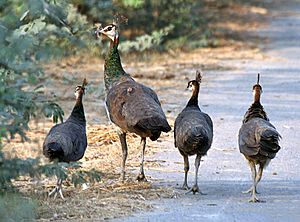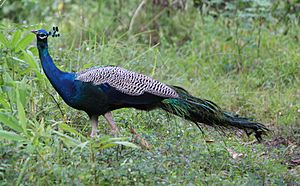Blue peafowl facts for kids
Quick facts for kids Blue peafowl |
|
|---|---|
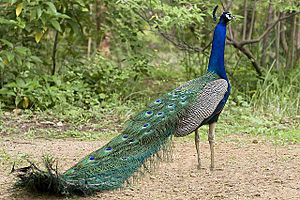 |
|
| Conservation status | |
| Scientific classification | |
| Kingdom: | |
| Class: | |
| Order: | |
| Family: | |
| Genus: | |
| Binomial name | |
| Pavo cristatus Linnaeus, 1758
|
|
The blue peafowl, also known as the Indian peafowl (Pavo cristatus), is a beautiful bird that comes from the Indian subcontinent. These amazing birds are famous for the male's huge, colourful tail feathers. They are the national bird of India.
Contents
About the Blue Peafowl
Peacocks are quite large birds. From their beak to their tail, they are about 100 to 115 cm (39 to 45 in) long. When a male's long tail feathers are fully grown, the bird can be as long as 195 to 225 cm (77 to 89 in)! They usually weigh between 4–6 kg (8.8–13.2 lb).
Female peafowl, called peahens, are a bit smaller. They are around 95 cm (37 in) long and weigh about 2.75–4 kg (6.1–8.8 lb). Indian peafowl are some of the biggest and heaviest birds in their family, called Phasianidae. Their size, bright colours, and unique crest make them easy to spot where they live.
What Peacocks Look Like
The male peacock has a shiny, metallic blue head with short, curly feathers. On top of its head, it has a fan-shaped crest. This crest is made of feathers with black stems and bluish-green tips. It has a white stripe above its eye and a white patch below its eye. The sides of its head have shimmery greenish-blue feathers.
The peacock's back has scaly bronze-green feathers with black and copper marks. Its shoulders and wings are a light brown colour with black stripes. The main flight feathers are chestnut, and the secondary ones are black. The actual tail is dark brown and short.
The most famous part is the "train." This is made of over 200 very long feathers that cover the tail. Almost all of these feathers have a fancy eye-spot at the end. The underside of the peacock is a dark, shiny green that turns black under the tail. Males also have a small spur on their leg.
What Peahens Look Like
Adult peahens have a reddish-brown head with a crest, similar to the male's. However, their crest tips are chestnut with green edges. Their upper body is brownish with lighter spots. Their flight feathers and tail are dark brown.
The lower part of a peahen's neck is metallic green. Their chest feathers are dark brown with a green shine. The rest of their underside is whitish. Young peafowl are pale brown with a dark brown mark on their neck. Young males look like females but have chestnut-coloured wings.
Peafowl Sounds
Peafowl are known for their loud calls, like a clear pia-ow or may-awe. They call more often before the rainy season starts. They might also call when they are alarmed or hear loud noises. In forests, their calls can warn other animals about predators like tigers.
They also make other sounds, such as a quick series of ka-aan..ka-aan or a fast kok-kok. When they are upset, they might let out a sudden, low honk!.
Different Colours and Mixes
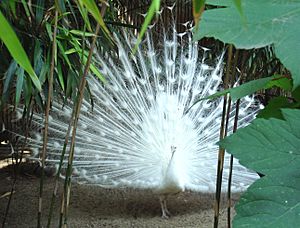
There are several different colour types of Indian peafowl. These are very rare in the wild. However, people have carefully bred them to create these colours in places where they are kept. For example, the "black-shouldered" type was once thought to be a different kind of peafowl. But it's just a natural genetic change within the species.
In this black-shouldered type, the adult male has black wings. Young birds of this type are creamy white with light brown wing tips. Other colour types include "pied" (patches of colour) and "white" forms. These are all due to small changes in their genes.
Sometimes, a male green peafowl (Pavo muticus) and a female Indian peafowl (P. cristatus) are bred together. This creates a mixed bird called a "spalding." This name comes from Mrs. Keith Spalding, who was a bird lover in California.
Where Peafowl Live
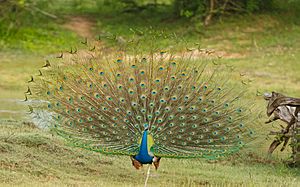
The Indian peafowl lives naturally across the Indian subcontinent. You can also find them in the drier lowland areas of Sri Lanka. In South Asia, they mostly live below 1,800 metres (1.1 mi) in height. Sometimes, they are seen as high as 2,000 metres (1.2 mi).
They live in moist and dry forests. However, they can also live in farmed areas and near human homes, especially where there is water. In many parts of northern India, people protect them because of religious beliefs. This means peafowl often look for food scraps around villages and towns.
Some people think Alexander the Great brought peacocks to Europe. Others believe the bird arrived in Athens by 450 BCE, or even earlier. Since then, people have introduced peafowl to many other parts of the world. In some places, they have become wild.
Besides their native home, humans have brought these birds to many countries. These include the United States, Mexico, Honduras, Colombia, Brazil, South Africa, Australia, and many more. In rare cases, Indian peafowl have even adapted to colder places, like northern Canada.
Peafowl Habits and Life
Peafowl are most famous for the male's amazing display feathers. These feathers actually grow from their back, not their tail. The "train" is made of very long feathers that cover the short, brown tail. The bright colours you see are not from paint or dye. They come from the tiny structure of the feathers, which reflects light in a special way.
The male's long train feathers only start to grow after its second year. They are fully grown when the bird is older than four years. In northern India, these feathers start growing in February and fall off at the end of August.
Peafowl look for food on the ground in small groups. These groups are called musters. They usually have one male and 3 to 5 females. After the breeding season, the groups are mostly made up of females and young birds. They like to be in open areas in the morning. During the hot part of the day, they usually stay hidden.
They love to take dust baths. As evening comes, groups walk in a line to a favourite watering hole to drink. If something disturbs them, they usually run away. They rarely fly to escape.
Peafowl make loud calls, especially during the breeding season. They might call at night if they are alarmed. Nearby birds might then call back, creating a chain of calls. Scientists have found about seven different types of calls from peacocks. Both males and females also make six common alarm calls.
At night, peafowl gather in groups to sleep in tall trees. Sometimes, they use rocks, buildings, or power lines. In the Gir forest, they choose tall trees on steep river banks. Birds arrive at dusk and call often before settling into their sleeping spots. Because they gather like this, many studies count them at these roosting sites.
How Peafowl Breed
Peacocks can mate with several females. Their breeding season is spread out but seems to depend on the rains. Peafowl usually become old enough to breed when they are 2 to 3 years old. Several males might gather in a special area called a lek. These males are often related to each other.
At the lek, males keep small areas next to each other. They let females visit them and do not try to keep a group of females. Females do not seem to prefer certain males. The males show off during courtship by raising their long tail feathers into a fan shape. They hold their wings partly open and drooped. They also shake their long feathers to make a rustling sound.
The male first faces the female and struts around. Sometimes, he turns to show off his tail. Males might also freeze over food to invite a female to eat. Males may display even when no females are around. When a male is displaying, females often seem uninterested and continue looking for food.
The busiest breeding time in southern India is April to May. In Sri Lanka, it's January to March, and in northern India, it's June. The nest is a shallow dip in the ground. It is lined with leaves, sticks, and other bits of nature. Nests are sometimes found on buildings.
A female lays 4 to 8 light-coloured eggs. Only the female sits on the eggs to keep them warm. The eggs hatch in about 28 days. The chicks can walk and follow their mother soon after hatching. Young chicks might sometimes climb onto their mother's back. The female might even carry them in flight to a safe tree branch.
What Peafowl Eat
Peafowl eat many different things, so they are called omnivores. They eat seeds, insects, fruits, small mammals, and even small reptiles. They will eat small snakes but stay away from larger ones. In the Gir forest in Gujarat, they eat a lot of berries from Ziziphus trees.
Near farms, peafowl eat many crops. These include groundnuts, tomatoes, paddy (unmilled rice), chilies, and even bananas. Around human homes, they eat all sorts of food scraps. In the countryside, they especially like garden plants.
Dangers to Peafowl
Adult peafowl can usually escape predators on the ground by flying into trees. However, large animals like leopards, dholes (wild dogs), and tigers can sometimes surprise them. In some areas, like the Gir forest, peafowl are often hunted by these powerful predators.
Looking for food in groups helps keep them safe. More eyes mean more chances to spot predators. Large birds of prey, like the crested hawk-eagle and rock eagle-owl, also hunt them sometimes. Chicks are more likely to be caught by predators than adult birds.
Peafowl living near people are sometimes hunted by pet dogs. In some parts of southern Tamil Nadu, people hunt them for traditional remedies that use "peacock oil." In zoos, peafowl have lived for 23 years. But in the wild, they are thought to live for about 15 years.
Protecting Peafowl

Indian peafowl are found widely in the wild across South Asia. They are protected by culture in many areas and by law in India. Estimates suggest there are more than 100,000 peafowl. However, illegal hunting for their meat still happens. This has caused their numbers to drop in some parts of India.
Peafowl breed easily when kept by humans. They are also kept as beautiful birds that roam freely. Zoos, parks, bird lovers, and sellers around the world keep breeding groups. This means there is no need to catch wild birds.
Hunting peacocks for their meat and feathers is a threat. Another danger is accidental poisoning from eating seeds treated with pesticides. Methods have been developed to tell if feathers were plucked or fell off naturally. This is important because Indian law only allows collecting feathers that have shed.
In some parts of India, peafowl can be a problem for farmers. They damage crops. However, they also help by eating many pests, like grasshoppers. They can also cause problems in gardens and homes. They might damage plants, attack their reflections in glass, scratch cars, or leave droppings. Many cities where peafowl have become wild have plans to manage them. These plans include teaching people how to prevent damage while treating the birds kindly.
Images for kids
-
Kartikeya with his consorts riding a peacock, a painting by Raja Ravi Varma.
See also
 In Spanish: Pavo real común para niños
In Spanish: Pavo real común para niños



